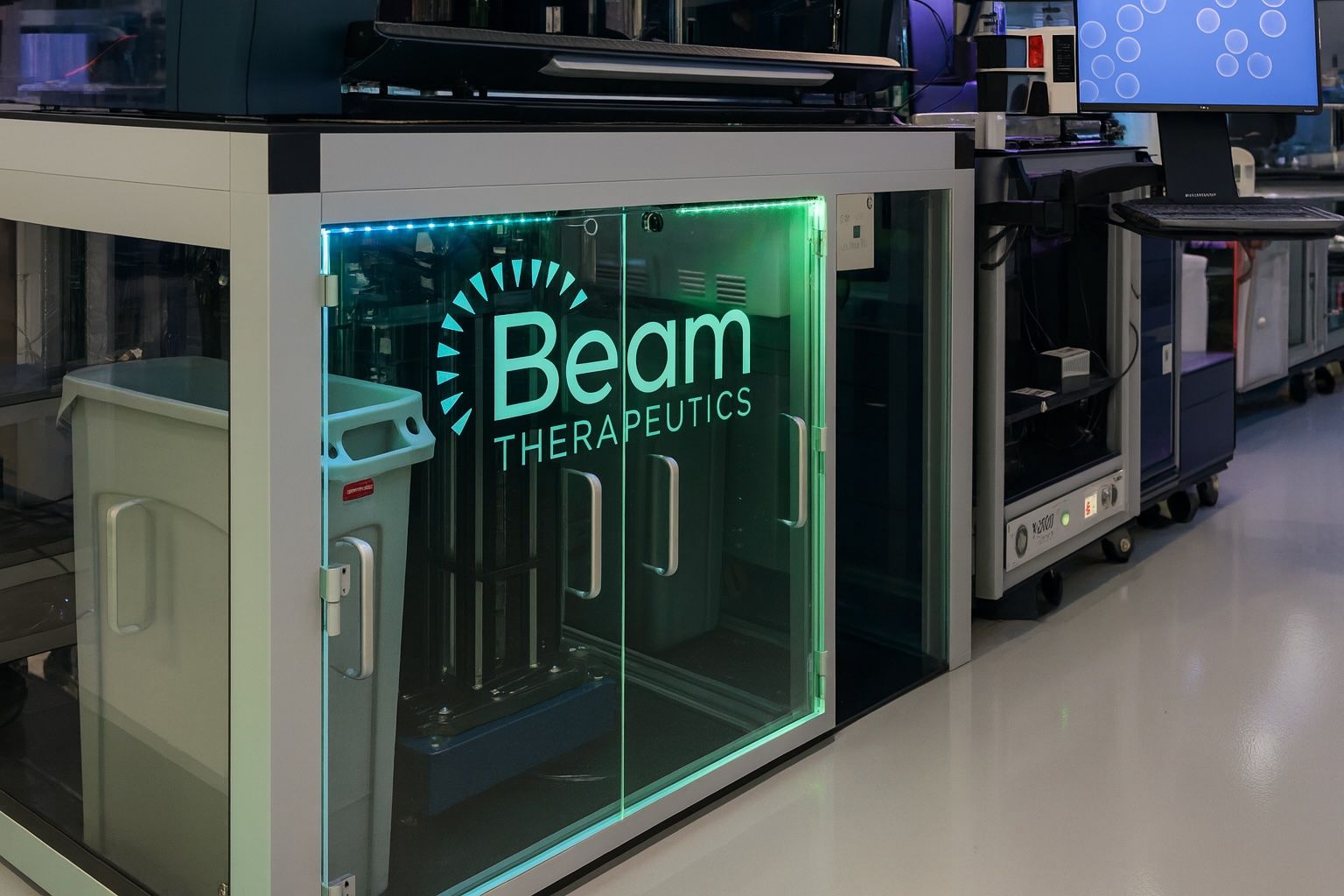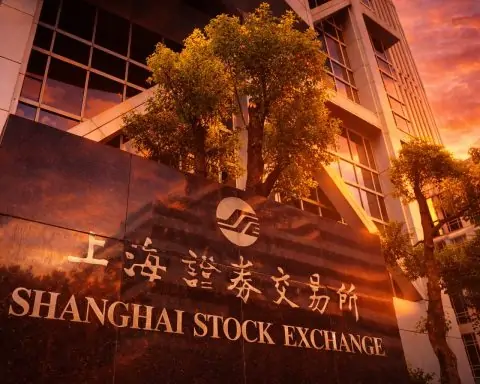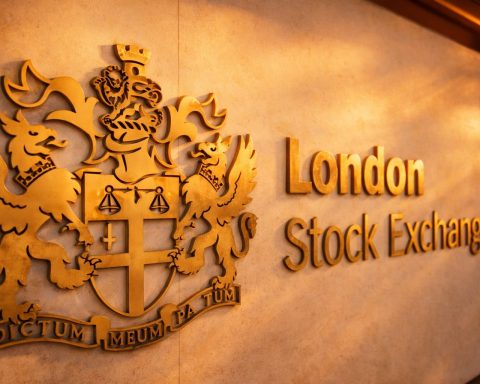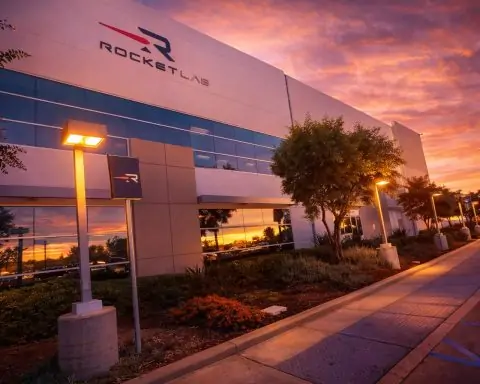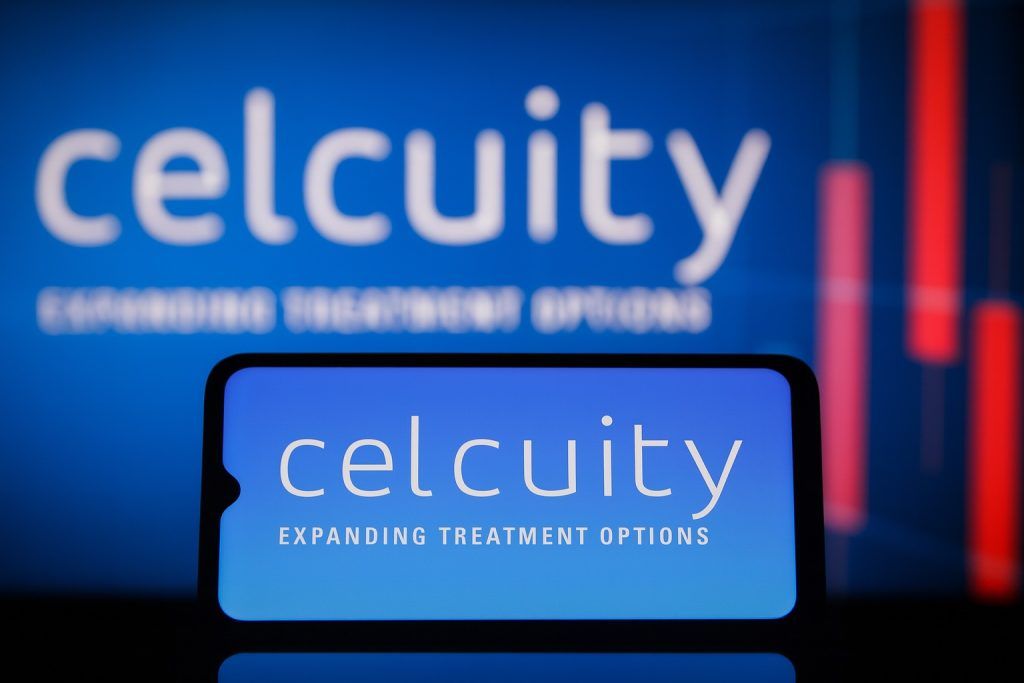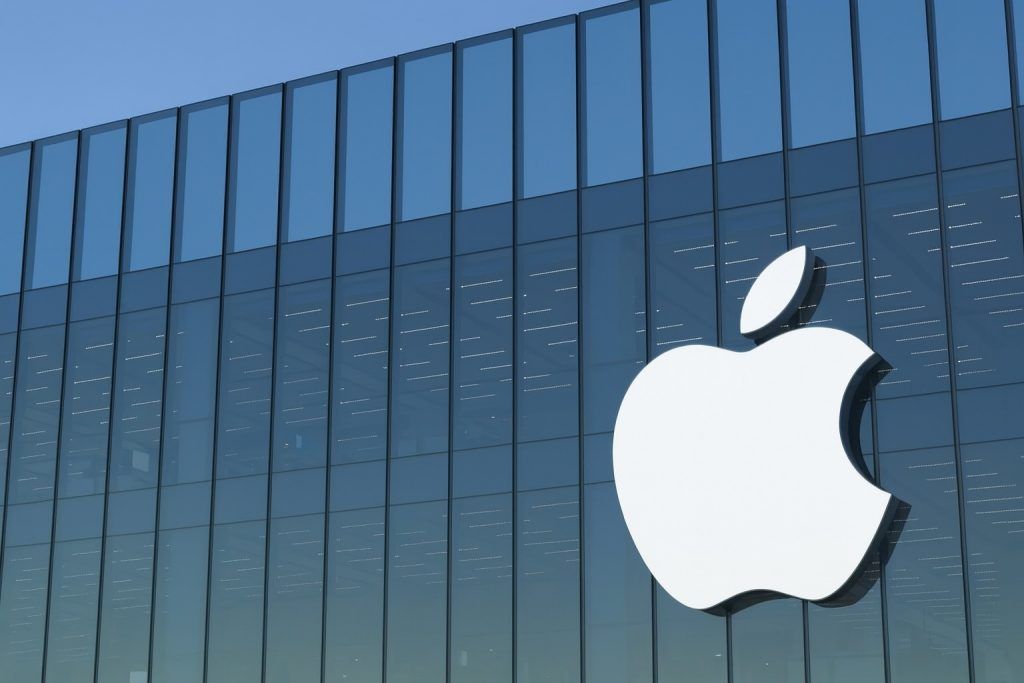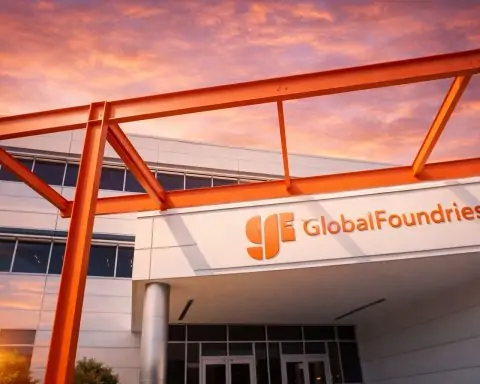- Beam Therapeutics (NASDAQ: BEAM) surged ~17% on Oct. 20, 2025, hitting around $30 per share – its highest level in months [1]. The stock has climbed nearly 20% over the past week amid bullish technical signals and sector momentum.
- Wall Street sees significant upside: BEAM’s average analyst price target is ~$45 (implying ~76% upside) with bullish outliers as high as $80 [2]. Jefferies recently initiated coverage at Buy with a $41 target [3], and H.C. Wainwright reiterated its Buy rating with an $80 target citing Beam’s “steady progress” across its pipeline [4].
- Pioneering pipeline gains FDA support: Beam’s lead programs use base editing (a next-gen gene editing approach). BEAM-101 (for sickle cell disease) earned FDA Regenerative Medicine Advanced Therapy (RMAT) status in August after early trial data showed 30 patients treated with no vaso-occlusive crises and robust fetal hemoglobin increases [5] [6]. BEAM-302 (for Alpha-1 Antitrypsin Deficiency) has Orphan Drug and RMAT designations [7] [8], with Phase 1/2 trials demonstrating dose-dependent gene correction and restored normal protein levels [9] [10].
- Recent results and financials: In Q2 2025 Beam posted a loss of $1.00/share (narrower than expected) on $8.5 M revenue [11], and ended the quarter with a strong $1.2 B cash reserve – enough to fund operations into 2028 [12]. The company is pre-revenue (its therapies are in trials), but positive clinical updates (e.g. BEAM-302’s early “proof-of-concept” success [13] [14]) have bolstered investor optimism.
- Gene-editing sector in focus: Beam’s rally comes amid renewed enthusiasm for biotech. Intellia Therapeutics shares jumped after reporting breakthrough CRISPR trial data (NTLA is +81% YTD as of mid-October) [15] [16], and CRISPR Therapeutics (maker of the first approved CRISPR-based therapy) is up ~76% YTD [17]. Big pharma is betting on the field too – this month Eli Lilly agreed to acquire base-editing peer Verve Therapeutics in a deal worth up to $1.3 B [18]. Beam’s +22% YTD rise [19] now outpaces the broader medical sector (≈0.4%) [20], though it trails the biotech gene-editing industry’s gains (~9% on average) [21], underscoring both the promise and volatility in this space.
Beam Stock Rallies on Technical Breakout
Beam Therapeutics’ stock surged on Monday, Oct. 20, extending a strong upward streak. By mid-afternoon the share price hit $30.35, up 16.8% for the day [22]. This marked BEAM’s highest price since early 2024 and a dramatic rebound from its summer lows. Traders point to a bullish “golden cross” pattern on Beam’s chart – the stock’s 50-day moving average recently rose above its 200-day average [23], a technical signal often seen as confirmation of a positive trend reversal. Zacks noted that BEAM had rallied ~6.8% over the prior four weeks leading into this golden-cross event [24], helping shift its Zacks Rank to #2 (Buy). The sharp Monday jump may have been fueled by momentum traders reacting to these technicals and upbeat analyst commentary (see below), as well as broader sector tailwinds.
Notably, Beam’s Monday spike coincided with strength in gene-editing peers. Rival Intellia Therapeutics (NTLA) – whose CRISPR-based therapy posted remarkable Phase 1 results – has seen its stock soar in recent weeks [25]. Intellia shares are up over 70% in the past month and ~81% year-to-date [26] after it reported that a one-time dose of its ATTR amyloidosis treatment led to a 92% reduction in a disease protein at 24 months [27] [28]. Meanwhile, CRISPR Therapeutics (CRSP), which co-developed the newly approved sickle-cell therapy Casgevy, has rallied roughly 50% from spring lows [29] and is +76% YTD [30]. Successes by these companies appear to be lifting investor confidence across the gene-editing space – a rising tide that benefited BEAM. “Success by one company can boost the sector (by validating the science),” noted TechStock², emphasizing how breakthroughs at Intellia or CRISPR are seen as de-risking the field [31].
Sector news also played a role in focusing attention on Beam. Just days earlier, Eli Lilly’s $1.3 billion acquisition of Verve Therapeutics – a base-editing startup targeting cardiovascular disease – underscored big pharma’s “willingness to pay up for genetic medicines”, according to industry observers [32]. Verve, like Beam, specializes in base editing (making single-base DNA fixes without cutting the double helix). This high-profile buyout, announced in mid-October 2025, highlighted the potential value of Beam’s technology and may have sparked speculation about strategic interest in Beam or its programs. Overall market sentiment was also favorable on Monday, with the Nasdaq Biotechnology Index and broader Nasdaq up on the day, providing a supportive backdrop for BEAM’s outsized move.
Key News and Catalysts
In the past few days and weeks, Beam Therapeutics has seen a flurry of positive news that set the stage for its stock upswing:
- Bullish Analyst Coverage: On October 17, Zacks Equity Research published an analysis highlighting that “Wall Street analysts think BEAM could surge 76.15%.” The report noted BEAM’s consensus price target of $45.43, based on 14 analysts, which is ~76% above the prior stock price (~$25.79) [33]. Price targets ranged from $20 (bearish) to $80 (highly bullish), indicating a wide divergence but overall optimism [34]. Crucially, analysts have grown more positive on Beam’s earnings outlook – at least one upward EPS revision came through in the past month, and none were revised lower [35]. This helped nudge the Zacks Consensus Estimate for Beam’s 2025 loss 2.9% higher (i.e. a slightly smaller loss expected) and contributed to Beam’s favorable Zacks Rank [36]. Such signals of improving fundamentals bolstered the bull case.
- Jefferies Initiation: In early October, Jefferies analysts began coverage of Beam with a Buy rating and a $41 price target [37]. This vote of confidence from a major investment bank added credibility. Similarly, BMO Capital Markets’ Kostas Biliouris in September reiterated an Outperform (Buy-equivalent) on BEAM with a $40 target, citing Beam’s cutting-edge technology and “strong position in the AATD market” thanks to BEAM-302’s potential [38]. BMO’s report highlighted management’s confidence in BEAM-302’s competitive positioning – a key reason for the bullish stance [39]. These endorsements from Wall Street likely drew in institutional buyers and speculative investors ahead of key data readouts.
- Mixed Analyst Views Temper Euphoria: It’s worth noting not all analysts are uniformly upbeat – some have more conservative outlooks. Back in August, JonesTrading actually lowered its price target for Beam from $34 to $25 (while maintaining a Buy rating) [40]. Analyst Soumit Roy at JonesTrading cited a shift to a more conservative valuation model for the cut, even as he acknowledged Beam’s “good progress” in trials [41] [42]. His $25 target (essentially where the stock was last week) reflects caution until more data materialize. Still, Roy remained positive on the fundamentals: at the time, he highlighted that 17 patients had been dosed in BEAM-302’s AATD trial with data “expected soon,” and that updated BEAM-101 sickle cell results are expected by end of 2025 [43]. He also praised Beam’s $1.15 billion cash pile (as of mid-2025) providing runway to 2028 [44]. The fact that even a lowered target was in the mid-$20s gave some validation to the stock’s prior floor. On the flip side, the high end of analyst targets remains very bullish – for instance, H.C. Wainwright’s Patrick Trucchio continues to peg BEAM at $80. In a September note, Trucchio maintained his Buy/$80 call, lauding Beam’s “steady progress” in both ex vivo (cell therapy) and in vivo base editing programs [45]. He specifically highlighted BEAM-101 as “advancing as a registrational candidate” for sickle cell and BEAM-302’s promising early data that “suggest it could be best-in-class” for AATD [46]. Such pipeline momentum underpins his optimistic valuation. This spectrum of views (from $25 up to $80 targets) was encapsulated in the recent Zacks piece, which cautioned investors not to rely solely on price targets but noted that a tight clustering of estimates can be a positive signal [47] [48]. In Beam’s case, the standard deviation of its targets is quite high (±$18) [49], reflecting uncertainty – typical for a clinical-stage biotech with binary outcomes ahead. Still, the consensus sentiment is that Beam has more upside potential than downside risk at current levels.
- Technical “Golden Cross” & Momentum: As mentioned, technical traders are zeroing in on BEAM’s chart. Last week, Zacks pointed out that Beam’s 50-day moving avg crossing above the 200-day is a bullish omen [50]. Historically, such “golden cross” patterns suggest the “downtrend … has bottomed out” and an “upward climb” may be underway [51]. Indeed, Beam’s stock had appeared to bottom in the mid-teens in early 2025 and has since more than doubled from its 52-week low of ~$13.5 [52] [53]. The recent upward momentum (+40% over three months [54]) indicates growing investor appetite. Trading volume on Oct. 20 was above average (around 2.9 million shares vs. ~2.6M avg) [55], suggesting new buyers (or short-sellers covering positions) piled in. Beam’s short interest remains notable at ~23% of float [56], so a rapid price jump can trigger a short squeeze as well. The stock’s beta of ~2.4 [57] signals high volatility, which is playing out on both the upside and downside.
Pipeline Progress and FDA Updates
Underpinning Beam Therapeutics’ market moves is its progress in developing precision genetic medicines via base editing. Unlike traditional CRISPR, which cuts DNA, Beam’s platform makes single “letter” edits to DNA, potentially offering greater safety and accuracy [58]. The company has several key programs, and recent news from these trials has been encouraging:
- BEAM-101 (Sickle Cell Disease): Beam’s most advanced candidate is a one-time, ex vivo gene-edited cell therapy for sickle cell disease (SCD). In mid-August, the FDA granted RMAT designation to BEAM-101 [59] – a status that conveys expedited review and enhanced guidance due to the therapy’s potential. (BEAM-101 already had Orphan Drug status for SCD.) This was awarded after Beam demonstrated promising early results in its ongoing BEACON Phase 1/2 trial, which has now dosed 30 patients [60]. Interim data (as of August) showed “strong increases in fetal hemoglobin” and a complete absence of vaso-occlusive crises post-treatment in these patients [61] – an extremely positive outcome, given painful crises are the hallmark of SCD. “That’s the speculative bottom there,” remarked CNBC’s Jim Cramer on Beam’s stock around that time, acknowledging the program’s promise but cautioning the stock was still a speculative play [62]. Beam’s President Giuseppe Ciaramella noted that the RMAT will “enable enhanced collaboration with the FDA as we advance toward a BLA filing” [63]. In other words, Beam sees BEAM-101 moving into registrational trials soon if data remain strong. The company plans to present updated BEAM-101 results by the end of 2025 [64] – potentially at the ASH (American Society of Hematology) conference in December. Investors will be watching those results closely as a read-through on efficacy (e.g. sustained fetal hemoglobin levels, long-term safety) and for any signal of timeline to a pivotal Phase 3 or biologics license application (BLA). Given that a rival CRISPR-based SCD therapy (Vertex/CRISPR’s Casgevy) is already approved, Beam-101 will need to show a differentiated profile – potentially better safety (since base editing might avoid some complications) or easier administration – to compete. So far, Beam’s management has hinted that BEAM-101’s fetal hemoglobin induction is quite robust, and the absence of crises post-engraftment is an excellent sign [65]. If confirmed in more patients with longer follow-up, BEAM-101 could indeed be “best-in-class” as a one-time cure for severe SCD [66]. Regulatory designations like RMAT should help speed interactions with FDA as Beam charts the path forward.
- BEAM-302 (Alpha-1 Antitrypsin Deficiency, AATD): Beam-302 is an in vivo base-editing therapy delivered via lipid nanoparticles to patient livers, aiming to correct the single-base mutation that causes AATD – a genetic disorder leading to liver and lung disease. BEAM-302 has garnered significant regulatory support: the FDA granted it Orphan Drug status in May 2025 [67], followed by RMAT designation (Regenerative Medicine Advanced Therapy) shortly thereafter [68]. These designations signal that early data are very promising. Indeed, Beam announced initial Phase 1/2 trial results for BEAM-302 in March 2025, showing “clinical proof of concept” – single doses in patients led to therapeutic-level increases in functional AAT protein and a significant reduction in the toxic mutant protein (Z-AAT) [69] [70]. Importantly, no serious safety issues were observed; all adverse events were mild/moderate and transient [71]. By August 2025, Beam had dosed 17 patients across four dose-escalation cohorts in Part A of the AATD trial (patients with lung manifestations) [72] [73]. CEO John Evans stated, “all doses tested as of Aug. 1 continue to be well tolerated and resulted in durable, dose-dependent correction of the disease-causing mutation” [74] [75]. In fact, at the 60 mg dose, patients saw functional AAT levels rise above the therapeutic threshold, while the pathogenic Z-AAT protein levels dropped markedly [76] [77]. This essentially means BEAM-302 is hitting its biological target – restoring the normal protein and removing the harmful one – which could halt or even reverse disease progression in AATD. Beam has responded by expanding Part A (adding more patients at 60 mg and 75 mg doses) and has now initiated Part B of the trial, which enrolls AATD patients with mild-to-moderate liver disease (with or without lung involvement) [78]. Part B will test a 30 mg starting dose in liver-affected patients, with potential dose escalation. This two-part approach lets Beam optimize dosing for both lung and liver disease populations. The company expects to share comprehensive data from Part A and Part B in early 2026 [79] [80], along with plans for a registrational study. Analysts like BMO’s Biliouris have flagged BEAM-302 as a key value driver, noting Beam’s “strong position” in the AATD space and management’s confidence that BEAM-302 could be highly competitive [81]. If BEAM-302 continues to perform, it could become the first therapy to address AATD at the genetic level – a potential game-changer for patients who currently have no curative options. Investors are watching for any interim updates (perhaps at liver disease conferences) on biomarkers or imaging for liver health in treated patients.
- Other Programs: Beyond these flagships, Beam is advancing a pipeline of earlier-stage candidates. BEAM-301 is a base-editing therapy for Glycogen Storage Disease Type Ia (GSDIa), which began dosing patients in a Phase 1/2 trial in early 2025 [82]. BEAM-103 is expected to enter clinical trials for an unspecified indication (possibly an inherited retinal disease or another liver target) – JonesTrading’s note referenced a Phase 1 start for BEAM-103 in planning [83]. Beam is also conducting preclinical research in oncology and immunology [84], leveraging its platform to create CAR-T cell enhancements or other cell therapies. While these programs are in the background for now, they contribute to the long-term story. The breadth of Beam’s pipeline, enabled by its base editing platform, is part of why analysts give it a high valuation – the company isn’t just a “one-drug bet” but rather a platform play in gene editing. Of course, successful translation of any program to an approved product is at least a few years away, and Beam remains unprofitable (net loss of $109M in Q1 and $119M in Q2 [85] [86]). This means upcoming clinical milestones (data readouts, potential Phase 3 starts) will be critical inflection points for the stock.
Regulators seem supportive so far, granting Beam’s lead programs expedited designations. However, approval pathways still require sizable pivotal trials. A key risk will be whether the FDA will accept surrogate endpoints (like biomarker improvements) or insist on clinical outcomes for approvals in AATD and SCD. Beam’s RMAT designations suggest willingness to discuss innovative trial designs, which could shorten time to market if outcomes remain positive. Investors will also be keen on any partnership news – for example, might Beam collaborate with a larger pharma to co-develop or commercialize one of these therapies (similar to CRISPR Therapeutics partnering with Vertex on Casgevy)? So far, Beam has preferred to develop its core programs independently (it has some partnerships on enabling technologies, but not major co-development deals announced in 2025). With cash over $1.2 billion, Beam appears funded to reach key data milestones without needing a near-term equity raise. Indeed, the company’s strong balance sheet was highlighted by analysts as a buffer against dilution [87]. (Beam raised $500 million in a private financing in early 2025, which bolstered its coffers [88].) This financial runway into 2028 gives Beam latitude to push multiple trials forward in parallel, a fact that long-term investors appreciate.
Market Context and Peer Comparison
Beam’s recent stock performance must be viewed in the context of a biotech sector rebound in late 2025, especially among genomic medicine companies. After a brutal 2022–2023 bear market, many gene-editing stocks hit multi-year lows earlier this year, only to bounce back on tangible clinical progress:
- Intellia Therapeutics (NTLA): Beam’s closest peer in in vivo editing has been a star performer lately. Intellia’s focus is CRISPR/Cas9 (not base editing), but its October update on an ATTR amyloidosis trial electrified investors – one dose led to sustained >90% reduction in a disease protein out to 36 months [89]. NTLA stock, which traded under $7 in spring, is now around $21 (up ~200% off its lows) and +81% YTD [90]. In fact, Intellia now sports a ~$2.3 B market cap, comparable to Beam’s ~$3.1 B [91] [92]. Both are small-cap biotechs with significant short interest (>30% of float for NTLA [93]). Intellia’s success in hitting clinical milestones (two Phase 3 trials underway) has set a benchmark – and it raises the bar for Beam to show that base editing can achieve similar or better results. Investors often lump these names together as part of the “CRISPR stocks” cohort, which can mean sentiment (or a Cathie Wood ARK purchase) moves them in tandem [94] [95]. For instance, ARK Investment’s genomics ETF (ARKG) holds positions in both Beam and Intellia [96] [97], so fund flows affect them similarly. On Oct. 8, ARK’s Cathie Wood even mentioned Beam as one of the genomic stocks ARK finds promising, amid ARK’s increased buying in the segment (per a Motley Fool report) [98].
- CRISPR Therapeutics (CRSP): As the most mature of the independent gene-editing pure-plays, CRISPR Therapeutics provides a glimpse of potential future for Beam if its programs succeed. CRSP’s gene-edited cell therapy Casgevy (for sickle cell and beta-thalassemia) won FDA approval in 2023 and launched in 2024. By mid-2025, roughly 115 patients had been treated or in process for Casgevy [99] [100], and the rollout is accelerating with expanded treatment centers and insurance coverage [101] [102]. That real-world progress has helped CRSP’s stock climb about +75% in 2025 [103], and its market cap stands ~$6.3 B [104] – roughly double Beam’s. CRISPR Therapeutics is also advancing a rich pipeline of in vivo gene editors (e.g. for cardiovascular risk factors ANGPTL3 and Lp(a), and for AATD via a non-base-editing approach called SyNTase) [105] [106]. Of note, CRISPR’s preclinical AATD candidate CTX460 (using a different gene-editing mechanism) showed >90% mutation correction in animals [107] [108]. This underscores that Beam-302 will face competition in AATD – multiple companies are racing to cure this disease via gene editing. However, analysts have pointed out that the “success by one company can boost the sector” [109] – CRISPR’s validation of gene editing in sickle cell has likely made regulators more comfortable and investors more optimistic about Beam’s parallel approach (Beam-101) in the same indication.
- Editas Medicine (EDIT): Another peer, Editas, focuses on older CRISPR tech and has struggled, with its stock roughly flat or down this year and a market cap around $340 M [110]. Editas’s setbacks (it discontinued a sickle cell program and laid off staff [111]) highlight the execution risks in this field. Beam, by contrast, has “multiple preclinical programs [and] no near-term pivotal trial yet” but a larger market cap ($2.6–3B) reflecting higher investor confidence [112].
- Broader Biotech & Market: The biotech sector overall (as measured by ETFs like XBI) was roughly flat to slightly up on the year coming into Q4 2025. Beam’s ~22% YTD gain now handily beats the +0.4% average for the healthcare/medical sector [113]. However, within biotech, especially the high-risk “Medical – Biomedical and Genetics” industry, many stocks rallied in H2 2025; the industry’s average YTD gain is ~8.9%, meaning Beam’s performance is a bit behind the pack [114]. This makes sense considering BEAM started 2025 under pressure – by August its shares were still down ~24% year-to-date [115]. Only in the fall did Beam’s trajectory reverse sharply into positive territory. The recent rally has now put Beam roughly +13% year-over-year [116], indicating that long-term holders (many of whom weathered a slide from ~$50+ in 2021) are starting to see recovery. Still, the stock remains well below its all-time highs (Beam traded above $100 briefly in 2021 during the gene-editing hype). For context, macro conditions – such as rising interest rates – have made investors cautious on cash-burning biotech companies earlier this year, but sentiment has improved as companies like Beam show real clinical progress and as M&A (like Lilly/Verve) signals that big players see value in these innovators.
Looking ahead, Beam Therapeutics has several catalysts on the horizon. Investors expect: (1) Updated sickle cell trial data by late 2025, which will indicate if BEAM-101 is on track for Phase 3 and how it stacks up against CRISPR-based rivals; (2) Possibly an announcement of Phase 3/BLA plans for BEAM-101 if data are compelling (RMAT could facilitate this discussion with FDA); (3) Further AATD trial updates – perhaps preliminary signals from Part B (liver patients) or any expanded cohort dosing news; (4)Q3 2025 earnings (likely in early November) where management might provide pipeline updates and guide R&D spending. Analyst commentary suggests the pipeline’s “momentum heading into key catalysts” is a core reason to be bullish now [117]. Any surprises – positive or negative – in these events will likely move the volatile stock significantly.
For now, Beam’s narrative is one of high risk, high reward. The company sits at the cutting edge of gene editing, aiming to translate Nobel Prize-winning science into cures for genetic diseases. Its stock is prone to large swings on sentiment – just in October it has traded from ~$25 to $30+ in a matter of days. High short interest and its designation as a “speculative growth” stock (Jim Cramer’s cautionary stance underscores this [118]) mean volatility will remain. But with approximately $3 B valuation against a $1.2 B cash war chest and several shots on goal in the clinic, Beam offers a unique risk-reward profile. As Patrick Trucchio of H.C. Wainwright put it, Beam’s base editing platform “could become the standard for safe and precise genetic corrections”, potentially placing the company “firmly among emerging biotech leaders.” [119] [120] Achieving that vision will depend on clinical data in the coming quarters. In the meantime, Beam Therapeutics has clearly re-entered the spotlight – and both Wall Street and Main Street will be watching closely if this gene-editing hopeful can fulfill the considerable hype that now surrounds its stock.
Sources: Financial news and data from Zacks, Insider Monkey, GlobeNewswire, StockTitan; ts2.tech analysis [121] [122]; Nasdaq & FinViz market data [123] [124]; company press releases [125] [126]. All information is current as of Oct. 20, 2025.
References
1. finviz.com, 2. finviz.com, 3. finviz.com, 4. finviz.com, 5. finviz.com, 6. finviz.com, 7. www.stocktitan.net, 8. www.stocktitan.net, 9. finviz.com, 10. finviz.com, 11. finviz.com, 12. finviz.com, 13. finviz.com, 14. finviz.com, 15. finviz.com, 16. ts2.tech, 17. finviz.com, 18. ts2.tech, 19. finviz.com, 20. finviz.com, 21. finviz.com, 22. finviz.com, 23. finviz.com, 24. finviz.com, 25. ts2.tech, 26. finviz.com, 27. ts2.tech, 28. ts2.tech, 29. ts2.tech, 30. finviz.com, 31. ts2.tech, 32. ts2.tech, 33. finviz.com, 34. finviz.com, 35. finviz.com, 36. finviz.com, 37. finviz.com, 38. finviz.com, 39. finviz.com, 40. finviz.com, 41. finviz.com, 42. finviz.com, 43. finviz.com, 44. finviz.com, 45. finviz.com, 46. finviz.com, 47. finviz.com, 48. finviz.com, 49. finviz.com, 50. finviz.com, 51. finviz.com, 52. ts2.tech, 53. finviz.com, 54. finviz.com, 55. finviz.com, 56. finviz.com, 57. finviz.com, 58. finviz.com, 59. finviz.com, 60. finviz.com, 61. finviz.com, 62. finviz.com, 63. finviz.com, 64. finviz.com, 65. finviz.com, 66. finviz.com, 67. www.stocktitan.net, 68. www.stocktitan.net, 69. finviz.com, 70. finviz.com, 71. finviz.com, 72. finviz.com, 73. finviz.com, 74. finviz.com, 75. finviz.com, 76. www.stocktitan.net, 77. finviz.com, 78. finviz.com, 79. finviz.com, 80. finviz.com, 81. finviz.com, 82. www.stocktitan.net, 83. finviz.com, 84. finviz.com, 85. www.stocktitan.net, 86. finviz.com, 87. finviz.com, 88. www.stocktitan.net, 89. ts2.tech, 90. finviz.com, 91. finviz.com, 92. finviz.com, 93. finviz.com, 94. finviz.com, 95. finviz.com, 96. finviz.com, 97. finviz.com, 98. finviz.com, 99. ts2.tech, 100. ts2.tech, 101. ts2.tech, 102. ts2.tech, 103. finviz.com, 104. finviz.com, 105. ts2.tech, 106. ts2.tech, 107. ts2.tech, 108. ts2.tech, 109. ts2.tech, 110. ts2.tech, 111. ts2.tech, 112. ts2.tech, 113. finviz.com, 114. finviz.com, 115. finviz.com, 116. finviz.com, 117. finviz.com, 118. finviz.com, 119. finviz.com, 120. finviz.com, 121. ts2.tech, 122. ts2.tech, 123. finviz.com, 124. finviz.com, 125. finviz.com, 126. finviz.com
